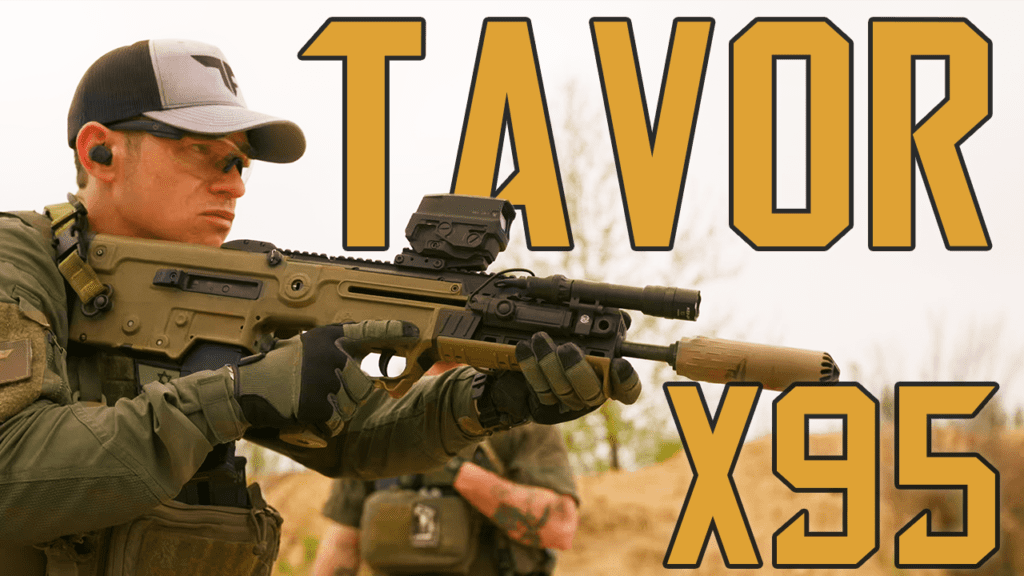Understanding and Optimizing the Tavor X95: A Structured Guide
Today, we’re diving into the intricate setup of the Tavor X95, as explained by Ron from Tactical Fitness. With over 14 years of experience in the IDF, Ron provides invaluable insights into the Tavor X95, offering practical advice for anyone looking to maximize their efficiency with this remarkable rifle. Let’s delve into the specifics. You can also review this blog in video format below!

Table of Contents
Background on the Tavor X95
Ron served in the Israel Defense Forces (IDF) for over 14 years, with more than a decade as a reservist. His connection with the Tavor X95 runs deep, as it has been his duty rifle. Interestingly, during his active duty, Ron transitioned from using the M16 and M4 to the Tavor X95 without any prior instruction. This challenging yet enlightening experience has allowed him to master the Tavor X95 over many years, both in service and as an instructor at the IWI Academy. Sign up for any of our Tavor Operator courses HERE!
Choosing the Right Suppressor for the Tavor X95
One of the standout features of Ron’s setup is his choice of suppressor. He emphasizes the importance of using a flow-through suppressor, such as the CGS, HuxWrx, or the new SilencerCo Velos. The Tavor X95’s heavily over gassed, long-stroke piston gas system can be quite unpleasant with a regular baffle suppressor, leading to significant gas blowback. Ron humorously notes that without a proper suppressor, users often look like coal miners after a few shots. Hence, a flow-through suppressor is essential for a more pleasant shooting experience.
Barrel Durability of the Tavor X95
It boasts a chrome-lined, hammer-forged barrel known for its durability. Ron shares that he has replaced the barrel only once due to extensive use, underscoring the longevity of the barrel. Typically, one can expect around 20,000 rounds before noticing any degradation in accuracy.
Optimizing Light Setup
For his lighting setup, Ron prefers the SureFire M600 series light. His setup allows him to access the light switch with either hand, providing flexibility and efficiency whether shooting from the right or left shoulder. This ambidextrous approach is particularly useful in dynamic shooting scenarios.
Choosing the Best Optics
Ron uses a Vortex UH-1 Gen II holographic sight, which performs reliably under various weather conditions. The holographic sight ensures that the reticle is always visible, an essential feature for someone like Ron who spends extensive time on the range, regardless of the weather. He mounts the sight on a Unity Tactical Riser, which offers a comfortable shooting height and maintains an upright position for an optimal sight picture.
The integrated iron sights serve as a reliable backup. They are lower 1/3 height and also function as night sights, providing versatility in low-light conditions. These foldable sights are a thoughtful addition, ensuring that the shooter always has a backup option if the primary optic fails.
Managing Gas Blowback
To manage the gas blowback when using a suppressor, Ron uses a Three Panther Products cover, Gas Buster. This cover significantly reduces the amount of gas hitting the shooter’s face, enhancing comfort during extended shooting sessions. The left-side breach cover, also from Three Panther Products, further mitigates gas issues, ensuring a more pleasant shooting experience.
Maintaining the Trigger
Ron’s retains the stock trigger, which he finds satisfactory. The trigger has a decent 5.5-pound pull weight and becomes smoother with use. Although not as crisp as an AR trigger, it provides a reliable and consistent performance suitable for various shooting applications.
Ideal Sling Setup
Ron uses a Savvy Sniper sling, which offers multiple adjustment options, including permanent and temporary adjustments as well as a bungee section for added flexibility. His preferred setup places the rear QD attachment on the right side of the rifle and another in the middle, near the bolt carrier. This configuration allows for easy side switching without the risk of choking or needing to remove the arm from the sling, optimizing the handling of the Tavor X95.
Sign up today for our IWI Tavor Operator Courses!
In conclusion, Ron’s meticulous approach to setting everything up reflects his extensive experience and practical knowledge. For those looking to optimize their Tavor X95, these insights offer a comprehensive guide to achieving peak performance. For more detailed instructions and hands-on experience, consider joining one of Tactical Fitness’s IWI Tavor operator courses. Visit tacticalfitnessaustin.com for more information.
